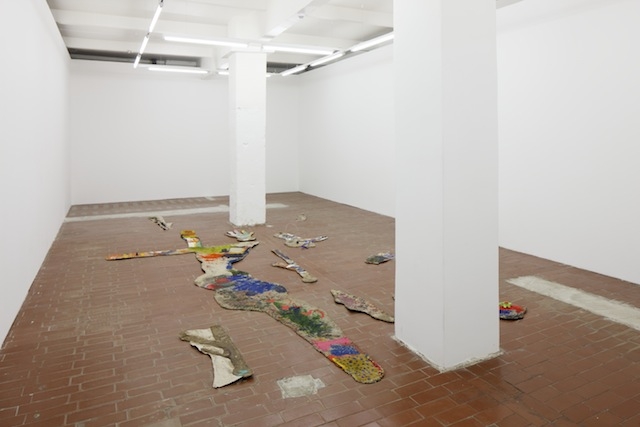Kim? Contemporary Art Centre, Riga, 24 March – 7 May
In what could be read as an ironic reference to the contemporary-art-averse cliché that ‘a child could do that’, Rodrigo Hernández actually got kids to make the work for The Shakiest of Things, which is otherwise billed as a solo show by the Mexican artist. A gang of seven- to nine-year-olds from a local primary school in Riga were given crayons to use as they wished on the walls of the first of the exhibition’s two rooms. The resulting chaos of colour, drawings and scribbles is undeniably cute. In the second room, Hernández led the same group in making papier-mâché sculptures. At the show’s opening these were laid out, not fully dry, on the gallery floor. On my viewing, towards the end of the show’s run, they were mounted on the walls: ten smaller works facing off a larger one across the room, approximately two metres in length. All were painted – splodgy, carefree marks of various colours – but most left visible some of the raw brown cardboard used in their construction. A few had craft and haberdashery materials attached or embedded: beads, thread, etc. One might hazard that one of the smaller works depicts a cat; another, a gun; a third, half a human figure (the basic stick-figure form is a motif in Hernández’s work, which often employs simple or faux-naive imagery). But these resemblances are slight and most of the sculptures are abstract. The larger sculpture, nevertheless, sprawls across the wall like a landmass, its multicoloured painted surface cracked like parched earth. A large central fissure threatens to break the work in two.
Yet there seems more to the artist’s gesture than just a joke. And nor, appearances aside, should we ‘dismiss’ the work as the product of a gallery education programme. Hernández was given the largest space at Kim? and invited to make a solo show, no strings attached. To return to the graffitied walls of the first room: various motifs appear, including a crude depiction of a family (with mum, dad and presumably the author of the drawing in the middle), flowers, mountains, fantastical creatures and names, such as the exuberantly scrawled LiNDA★. There is in fact a riotous, anarchic freedom to this work. (I’ve seen something similar on such a scale once before: a vast tarpaulin by The Edge Group, a radical artist collective from the Bulgarian city of Plovdiv, originally placed in a public space in April 1990 as the Soviet Union disintegrated and Bulgaria embraced freedom. Residents were likewise invited to scrawl on the blank material, the result a similarly crazy, varied, joyful mass of self-expression.)
In both the graffiti and the sculptures, all the basic subjects of art history are represented: the self, landscape, nature, the monstrous and the fantastical. The desire to depict such things is perhaps a primal one: that thought in turn recalls Matisse and the later CoBrA artists, who were likewise inspired by children’s creativity, and A. R. Penck’s early ‘standart’ works, in which the late German artist returned to early or ‘primitive’ motifs with the aim of creating a radical, universal language. Hernández is working in this tradition, an expression of free social construction, as opposed to self-expression: a representational language through which a Mexican artist, Latvian children and the viewer can communicate. His move here was a risky one – it could easily come off as gimmicky – but pays off in its timely reminder that for all our constructed differences, nonverbal, nonlinguistic, representation, uncorrupted and unconditioned by learned prejudice, exists in the mind of a child.
First published in the Summer 2017 issue of ArtReview
